Is iron ore done and dusted?
It is the second day of September, the Cherry Blossoms have bloomed by Lake Burley Griffin, the Wood Ducks are fighting over nesting sites, and the Magpies are cranky. Oh... and iron ore, the commodity, fell out of bed (again) and all is doom and gloom on a nice spring day. Should we worry? Well, that depends on the investor, their time horizon, and the view out front.
In this wire, which reprises Where's iron ore headed from here?, penned this time last year, we outline what has changed since then, and which parts of the iron ore complex interest us.

Reprising the cost-basis method for analysing sentiment
Since I have written here before on the subject of cost-basis analysis, I will not reprise the full explanation of the method here. However, see below for a longer form research report.
As we have outlined in previous wires on iron ore stocks, and tax loss selling, there is some value in viewing investor sentiment objectively in the same way that we do fundamentals.
This may seem odd, at first, but makes sense when we consider the likely sources of pleasure and pain for investors in stocks. These are not too hard to identify.
Nobody likes to lose money. Everybody likes to make money.
Objectively, if you, me, anybody, everybody, is making money, we might pinch ourselves, but, likely as not, the mood will be merry and champagnes sales are booming. The opposite is true when everybody is losing money. Champagne sales are down, and misery is widespread.
When we come to consider this principle for the stock market, it is easy to see why the trend of company profits matter. However, it is harder to understand why the reactions to changes can be so extreme. Bear markets are clearly different from bull markets, and not only because of the direction of stock prices. The psychology of both markets is different.
If you don't believe me, then try this fun exercise.
Take a bull market period, as identified in any way that makes sense to you. Now print out some stock charts from that period. Now do the same for those stocks in a bear market.
Paste them on the wall, with bull to one side, and bear to the other. Stare at them a bit. Then turn all of them upside down, but keep them each to the same side. It does not matter if the bulls are to the left and the bears are to the right. What matters is how the charts look when right-side up and when up-side down. You probably already know the answer:
Stocks go up in bull markets via the escalator, and down in bear markets via that cavernous lift well you never saw which just opened up in front of you.
The basic point is that market psychology is asymmetric.
Going up feels a ton better than going down but up is slow and down is quick.
Needless to say, nobody really knows how to tell when the lift well is about to open up, but it can help to diagnose the situation when it has. That is what cost-basis analysis is for.
The cost-basis method in a nutshell
In simple terms, what we do is use some basic math and some quality trading data on the history of trades in a given stock to estimate what the typical investor paid for their shares.
The figure below explains the basic idea, in a nutshell.
We know that every share of a company is owned by somebody and that investor will have paid a price to buy it that is reflected in the trading history of the market. The share registry may well know what those prices are, and the investor identity, but we don't really need to know that information. There is a natural update rule to estimate how we should use new trading data to update a prior estimate of the distribution of share ownership.
In the figure, we imagine a known distribution for all shares outstanding, that is shown as the relative volume traded at each historical price. Leave aside how we go that. Suppose one new trade is made, so many shares, at the price we see in the market. We have to put this data in the distribution, but we do not know which actual share was sold. Statistically, we might suppose that it is equally likely to have come from anywhere.
In mathematical terms, this means we must blend the old distribution with the new data by adding them together with two proportions that add up to one. This is intuitive, we have to keep track of where all the shares went, and we have not got any new ones.
For the ratio, you may convince yourself that an appropriate estimate is to take the traded volume and divide it by the total number of shares of the company. Of course, if some of the shares never trade, then you may want to adjust this rule, but that is detail.
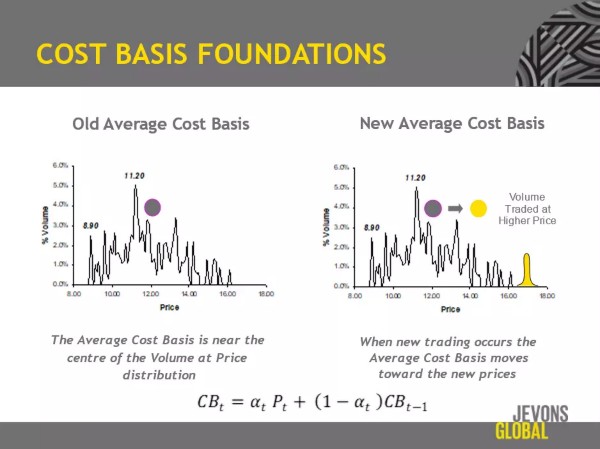
Once we see the logic of cost basis, it is natural to explore it. The distribution is unwieldy, but the average cost basis is pretty simple. It is that price at which the average profit and loss of investors in their stocks exactly balances out. It is the investor break-even.
This is the magical level at which investor sentiment is balanced, and we can think very clearly about value. If the average assessment of fundamental value is above that level, we expect the stock to have a tendency to rise. If it is below, we expect a tendency to fall.
That is really all there is to it, with one small twist.
The mathematical rule for updating average cost-basis is exactly the same as the exponential moving average used by technical analysts, with one small difference. Normally, technical analysts choose a family of averages with different constant blend factors, the alpha variable on the slide that tells how much of the new price, and the old average we should mix.
Cost-basis uses a variable blend factor that comes directly from the market. We do not pull it from thin air, we simply use the pace of market trading to guide how short or long the market memory should be, when updating the moving average. This is the main difference, but not an essential one, since the typical interpretation of technical analysis applies:
When a stock is trading up from below the average investor break-even it is likely to encounter resistance at that price level, and may trade back down.
or, in the converse situation
When a stock is trading down from above the average investor break-even it is likely to encounter resistance at that price level, and may trade back up.
In our approach to markets, we consider fundamental value to play an important role in the market decision to treat cost-basis as support or resistance.
I have been doing this for more than twenty years, and have learned what things to look out for in calculating the indicator, and something of what it means for the state of a stock market.
I can summarize my learnings in one simple rule:
The market acts as a voting machine away from average cost-basis, and as a weighing machine when trading near cost basis.
This simply means that positive sentiment can support stocks far above fair value, and that negative sentiment can sink stocks far below fair value. However, at key junctures in the passage from bull markets to bear markets and vice versa, fundamentals are key.
That is why I pay attention when stocks, and markets, trade near average cost basis.
Application of the cost-basis method to iron ore stocks
The right hand column, marked "Profit & Loss", shows estimates of the unrealized profit and loss for ASX-listed iron ore producers with a market capitalisation > $500M AUD. BHP.AX alone is 70% of the aggregate market capitalization, RIO.AX is 14% and FMG.AX is 10% with MIN.AX sitting at 3% and the pellet iron juniors CIA.AX at 0.7% and GRR.AX at 0.25%.
Note that all stocks with well-populated forward earnings estimates trade below 8x PER on a one year forward basis (using Refinitiv estimates data). Of course, in a soft commodity market earnings can be further downgraded, but these are not peak multiples. However, we can also see that only two stocks, namely MIN.AX and BHP.AX are above break-even. In the case of Mineral Resources, investor sentiment is clearly very positive. Since this is the only stock with operating mines for lithium extraction, we interpret that to be driven by lithium, and not the iron ore business which is not of the same quality as the operations at BHP.AX. The others are all trading below cost basis, and therefore prone to a further negative erosion of sentiment.
On that basis, our approach is to consider BHP.AX as an opportunistic buy, for topping up our long term holdings, but to stand back from activity in the other names, except for the purpose of rebalancing in taking whatever other positions in the market that warrant attention. Since lithium is strong, we prefer pure exposures there, but stand aside from MIN.AX.

That is the simple way to use average cost basis as an aid to forming a tactical assessment of where to trade, and where to stand back from trade and do some research.
On the latter point, FMG.AX has a decarbonization angle with Fortescue Future Industries. That is a great long-term strategy that is most likely to get cheap late in a bear market.
For the decarbonization theme, more broadly, we like both CIA.AX and GRR.AX for their exposure to the niche market of pelletized iron ore, which is higher grade and achieves premium prices. However, the stocks are trading down below cost-basis in a fast moving market for iron ore. It seems prudent to wait these out, and put energy into research.
The best antidote to market volatility is to properly separate thought frim action. We might think that pelletized iron ore has a great future, but bear markets have a habit of knocking down the future promise of any company to the level of a current bargain.
BHP.AX is a known quantity to us, and we think it is good buying at these levels.
A wrap-up tour of iron ore by the charts
Since this method of analysis is not widely available I include the relevant charts.
The first is for BHP.AX. It is trading right around estimated average cost basis, and seems to be fairly valued to us. The stock has traded much further below cost basis, as in March 2020, but we do not judge the present demand driven inflation crisis to warrant the same discount.
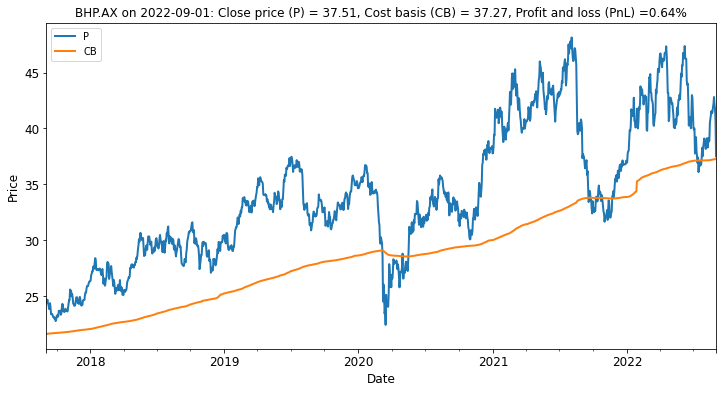
Note that the BHP chart appears with a different price level, as compared to that in our earlier article, due to the in-specie distribution of Woodside Energy shares on 24-May-2022. There is a kink in the cost-basis level around that event, where historically adjusted price data moved down by a ratio of 0.8904 prior to the distribution.
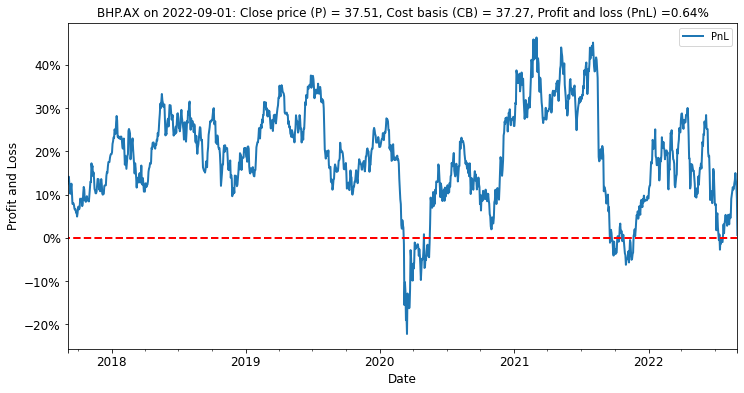
When the same chart is viewed in profit and loss form, we can see that sentiment does move in swings from +30 to 40% unrealized profit to a general low around 10% on minor retreats and to cost basis, or below in bear markets. For reference, -40% is a typical drawdown in extreme bear markets, such as we saw in 2008, during the Global Financial Crisis (GFC).
The chart for RIO.AX looks less healthy, and perhaps there are controversies in the market that help explain why. Rio Tinto has had a number of incidents, such as the infamous Juukan Gorge affair, where they blew up First Nations scared sites, which have led some investors to stand back from the name. However, they also have some ongoing questions regarding grade and future development of their current Pilbara operations.
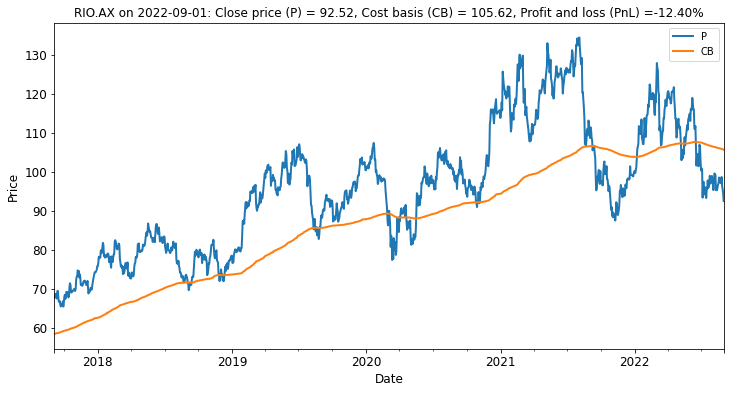
While we were one of those investors who considered these issues to have passed, and had taken positions in the name, around March 2022, they have resurfaced in other areas.
Hopefully, the company takes heed from the market and makes more strenuous efforts to reassure their investor base that they understand the need for social license.
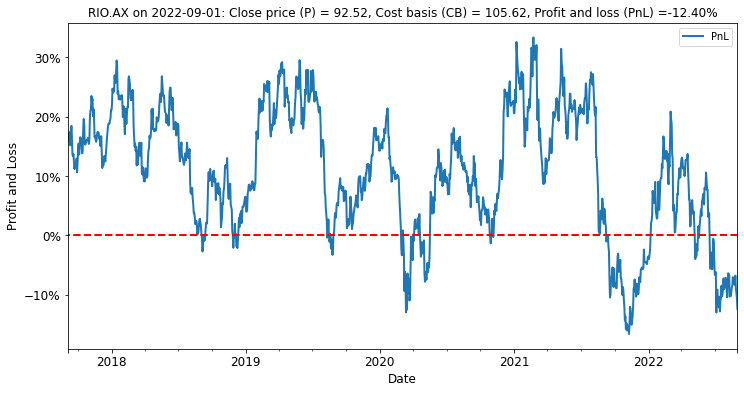
In the case of FMG.AX, there is little forward motion for the stock price, but a great deal of very furious paddling in the promising new direction of Fortescue Future Industries (FFI). There is much to say that is positive about this trend, but investors likely think it will cost something.
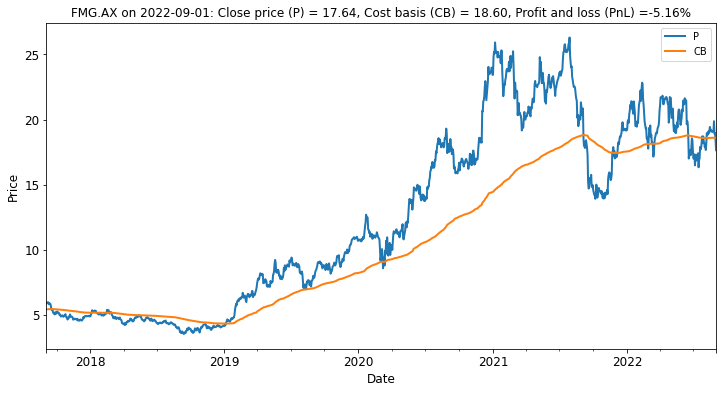
Everything good. noble, and worthwhile costs something. We cannot fault the ambition, but we infer from the unrealized profit and loss chart that many investors of good purpose may just be standing aside for the moment, until the present turmoil in markets blows over.
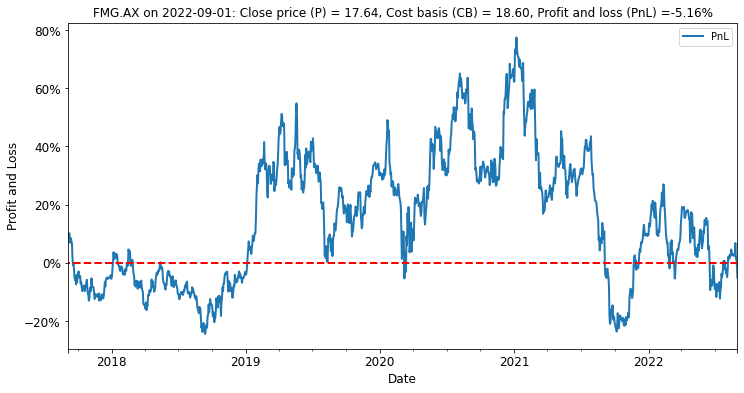
MIN.AX is one of the truly great entrepreneurial success stories of the recent commodity cycle. The market has oscillated between the firm view that iron ore is good, and lithium is bad, or that the lithium is good and iron ore is bad. Good management pays no attention to such worry, but we think there is probably another spin of this wheel to bring it lower.
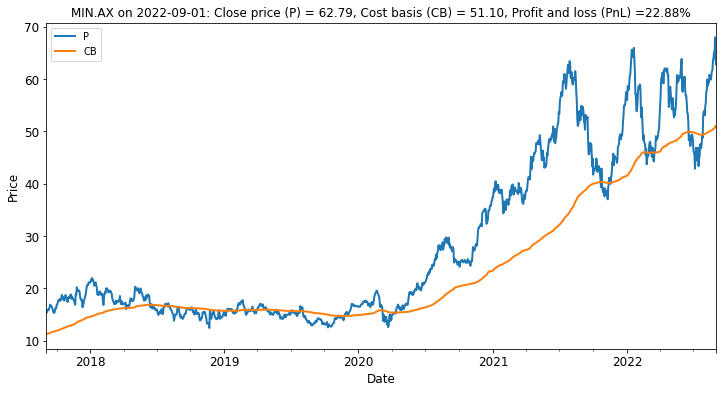
Another tilt lower on profit taking is possible. That likely depends on whether lithium wobbles later in the bear market. We cannot know, but pure play lithium stocks look better to us.
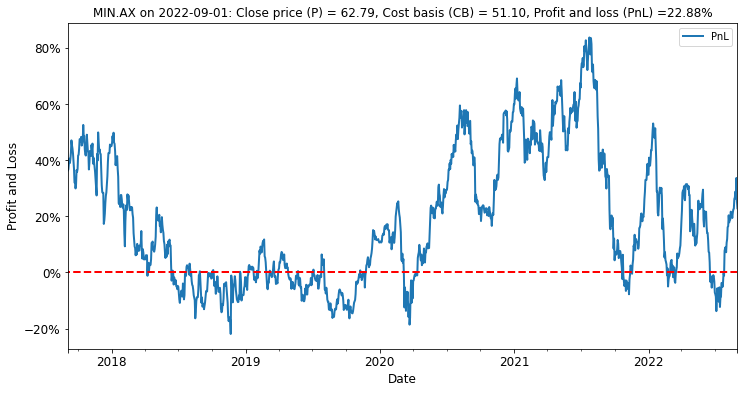
CIA.AX is interesting for the return of their Canadian Labrador mining operation. Sentiment is poor in the short run, but the stock warrants research to understand better what effect the war in Ukraine will have on supply of pelletized iron ore feed stock into global markets.
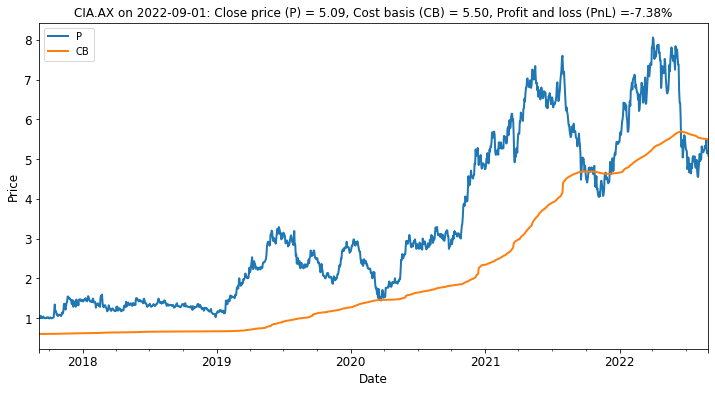
This recent period of trade shows deteriorating sentiment which is consistent with a pause in investor sentiment as analysts ponder the uncertainty of Chinse demand and Russian supply.
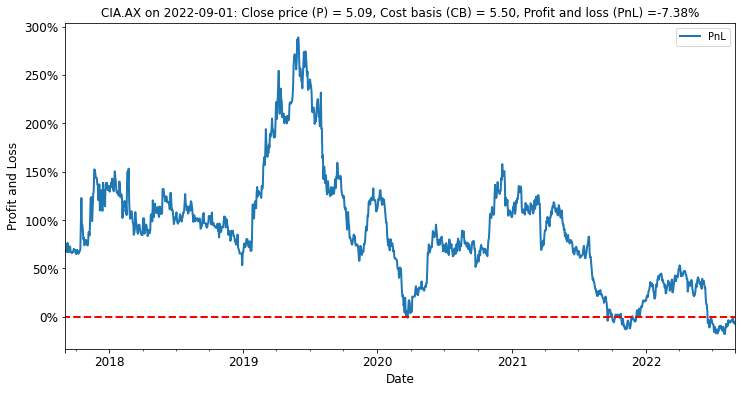
Similar conclusions apply to GRR.AX, as we indicated for CIA.AX.
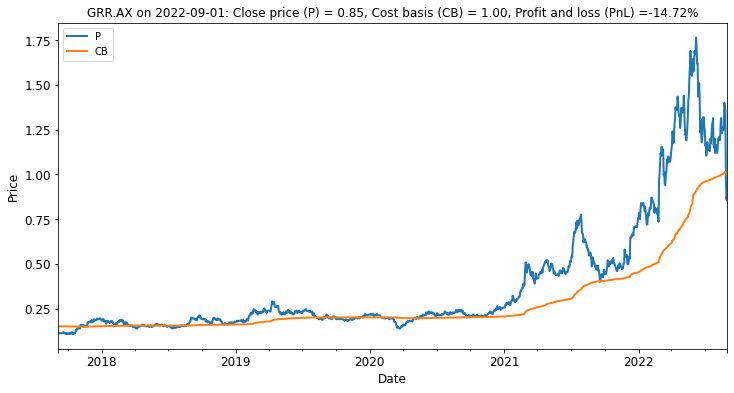
Grange Resources was whacked post their earnings result, so this market needs to settle.
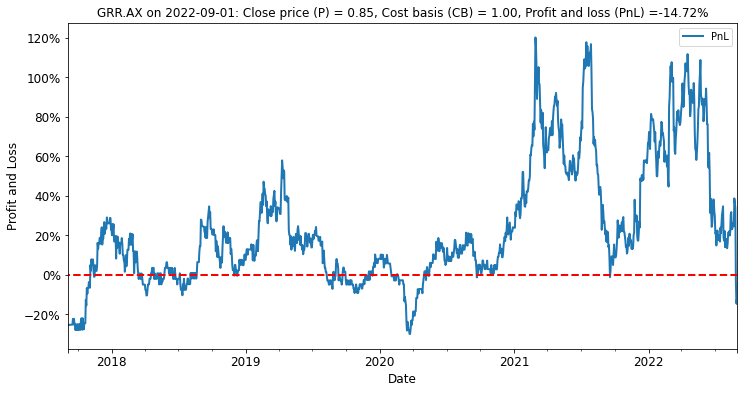
Finally, we have Mount Gibson Iron, MGX.AX. The bear market started earlier, and has been a lot deeper for this stock, so far. That reflects lower grades on smaller operations.
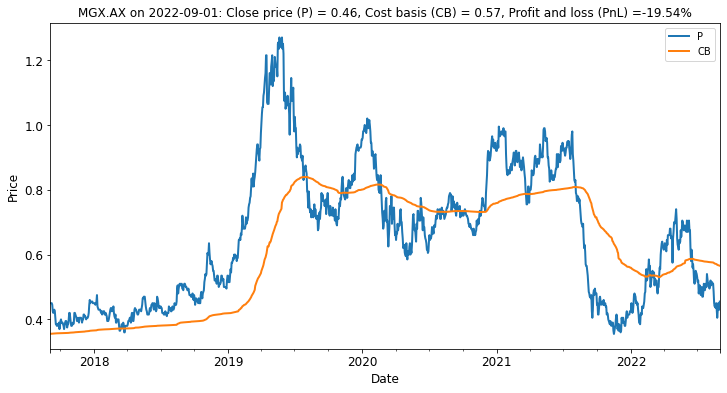
The main interest in stocks like MGX.AX is to track their progress on turn around. That likely requires better iron ore prices, and perhaps new growth opportunities for the company.
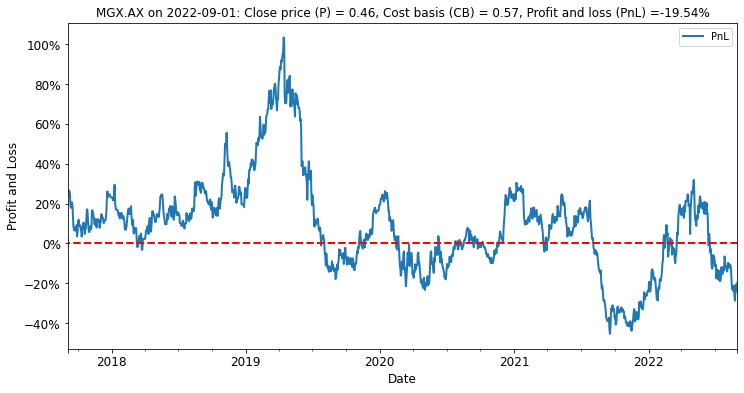
That concludes our brief tour of the iron ore majors.
There is a long-form research report attached for your download below.
Sentiment is a new area of analysis for most investors. Please feel free to share your views or or questions in the comment section below.
If you like this approach to markets please follow me.
Disclosure: the author owns shares in BHP Group, Rio Tinto and Grange Resources.
Picture Credit: "The Scream" (image cropped), by Edvard Munch (1910). Reproduction sourced from Google Art Project. Rights: © Munch-museet/Munch -Ellingsen Gruppen/Bono
Never miss an insight
Enjoy this wire? Hit the ‘like’ button to let us know. Stay up to date with my content by hitting the ‘follow’ button below and you’ll be notified every time I post a wire. Not already a Livewire member? Sign up today to get free access to investment ideas and strategies from Australia’s leading investors.
5 topics
7 stocks mentioned

